Long-billed mockingbird
| Long-billed mockingbird | ||||||||||||
|---|---|---|---|---|---|---|---|---|---|---|---|---|

Long-billed mockingbird ( Toxostoma longirostre ) |
||||||||||||
| Systematics | ||||||||||||
|
||||||||||||
| Scientific name | ||||||||||||
| Toxostoma longirostre | ||||||||||||
| ( Lafresnaye , 1838) |
The long-billed mockingbird ( Toxostoma longirostre ) is a species of bird from the mockingbird family (Mimidae). This species has a large distribution area, which is limited to the countries of Mexico and the USA . The IUCN assesses the population as Least Concern .
features
The slim long-billed mockingbird reaches a body length of around 25.5 to 28 centimeters and weighs around 70 grams. The long, slightly curved bill is black, slightly lighter at the base of the beak. The legs are gray flesh-colored. The brown head with slightly gray tones in the facial area is often bordered by a dark beard. The eyes are yellow-orange to orange in color. The top is deep brown to cinnamon brown, with the rump and tail being the lightest. On the wings they have two whitish stripes and on the outer control feathers with lighter speckles. The throat and the entire underside are white with dark lines on the cheeks and rough black stripes on the chest and sides. The gloomy central scattering feathers and under tail coverts are difficult to see in the field. There is no pronounced gender dimorphism between the sexes .
Juveniles have fewer markings on the face and underside. In addition, the stripes on the wings are light brown-yellow.
distribution and habitat
They move in dry to semi-arid scrub forest areas and their edges, dense bushes and hedges. Here they occur on the Atlantic slopes from sea level to heights of 1500 meters.
behavior
They usually hide on the ground or close to the ground. To search for food, they go to the ground and scour it for insects. Often you can see them sitting on branches and hear a loud cleeooeep whistle. Their nest is a globular bowl of twigs and grass that they build in the middle stratification layers in bushes and trees. There they lay 2 to 5 blue-white eggs, which are streaked with dense red-brown and gray spots. Both parents take part in building the nest and hatching the eggs.
Subspecies
Two subspecies have been described, which differ mainly in their coloration and distribution area:
- Toxostoma longirostre longirostre (Lafresnaye, 1838) The nominate form is present from the southeast of the Mexican state of San Luis Potosí to the southern part of northern Veracruz .
- Toxostoma longirostre sennetti ( Ridgway , 1888) The subspecies occurs in southeast Texas south of Corpus Christi to northeast Mexico (replaces the nominate form in the northern part of north Veracruz). The top looks more cloudy and grayer than in the nominate form.
Etymology and natural history
The scientific name Toxostoma is made up of the Greek words toxon (= bow) and stoma (= mouth). The second name longirostre is derived from the Latin words longus (= long) and rostrum (= beak). With the use of the word sennetti in a subspecies Robert Ridgway honored the businessman, naturalist and ornithologist George Burritt Sennett (1840-1900). This is also the reason why you can also find the common English name Sennett's Thrasher in some authors .
Lafresnaye used the name Orpheus longirostris in his first description . An illustration of the bird was made a little later in 1839 in the Magasin de Zoologie . The black and white drawing to the text came from the French artist Jean-Gabriel Pretre (1768-1849), the engraving made Jean Charles Pardinel (1808-1867) and the pressure was carried out by N. Rémond. Only later was the bird classified in the genus Toxostoma.
literature
- Steve NG Howell, Sophie Webb: A Guide to the Birds of Mexico and Northern Central America. Oxford University Press, Oxford 1995, p. 600, ISBN 978-0198540120
- Roger Tory Peterson: A Field Guide to the Birds of Texas: And Adjacent States , Houghton Mifflin, 1998, p. 260, ISBN 978-0395921388
- Michael K. Rylander: The behavior of Texas birds , Audio Forum, 2002, p. 293 f, ISBN 978-0292771208
- Frank Michler Chapman , Chester Albert Reed: Color Key to North American Birds. D. Appleton & Company, p. 233, 1912.
- Joel Ellis Holloway, George Miksch Sutton: Dictionary of Birds of the United States: Scientific and Common Names , Timber Press, 2003, p. 202 ISBN 978-0881926002
- Bo Beolens, Michael Watkins: Whose Bird ?: Common Bird Names and the People They Commemorate , Yale University Press, 2004, p. 307, ISBN 978-0300103595
Web links
- Videos, photos and sound recordings of Long-billed Thrasher (Toxostoma longirostre) in the Internet Bird Collection
- Avibase Long-billed Mockingbird (Toxostoma longirostre) pictures and other information
- Xeno-canto Toxostoma longirostre voice recordings
- Picasa web albums Long-billed Thrasher (Toxostoma longirostre) ( Memento from April 29, 2016 in the Internet Archive ) Image
- Mangoverde Long-billed Thrasher Toxostoma longirostre Pictures and information
- Animal Diversity Web Toxostoma longirostre (long-billed thrasher) picture
- Mike Danzenbaker Long-billed Thrasher Toxostoma longirostre Picture Show
- Flickr Long-billed Thrasher (Toxostoma longirostre) image
- Flickr Long-billed Thrasher (Toxostoma longirostre) image
- Flickr Long-billed Thrasher at Quinta Mazatlan Nature Center picture
- All About Birds Long-billed Thrasher Information and Picture
Individual evidence
- ↑ Toxostoma longirostre in the IUCN Red List of Threatened Species 2010.3. Listed by: BirdLife International, 2009. Retrieved September 4, 2010.
- ↑ Revue zoologique par la Société cuviérienne 1838 p. 54f Note sur espèce nouvelle du genre moqueur, Orpheus, suivie du catalog synonymique des dix espèces qui composent actuellement ce genre. Par M. de La Fresnaye (French) original article
- ↑ Magasin de Zoologie, d'anatomie comparee et de palaeonthologie, reoueh 1839 Orpheus longirostris
